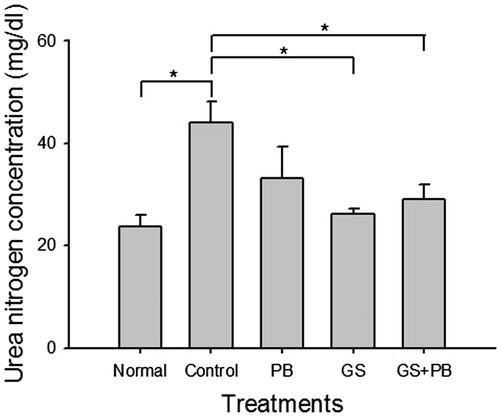Figures & data
Figure 1. Effects of orally administered probiotic-fermented red ginseng on (A) body weight changes and (B) water intake in STZ-induced diabetic mice. Body weight changes and water intake were measured in normal untreated mice (Normal), STZ-induced diabetic mice (Control), STZ-induced diabetic mice treated with probiotics only (PB), STZ-induced diabetic mice treated with red ginseng (GS), and STZ-induced diabetic group of mice treated with probiotic-fermented red ginseng (GS + PB), as described in the “Materials and methods” section. Data are presented as means ± SD (n = 8). *p < 0.05, **p < 0.01 and ***p < 0.001 indicate significant differences.
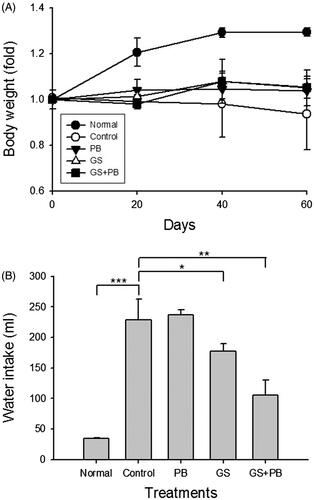
Figure 2. Effects of orally administered probiotic-fermented red ginseng on levels of blood glucose (A) at the 8th week of diabetes induction and (B) after intraperitoneal glucose injection at the 8th week of diabetes induction in the STZ-induced diabetic mice. Blood glucose levels were measured in normal untreated mice (Normal), STZ-induced diabetic mice (Control), STZ-induced diabetic mice treated with probiotics only (PB), STZ-induced diabetic mice treated with red ginseng (GS), and STZ-induced diabetic mice treated with probiotic-fermented red ginseng (GS + PB). Data are presented as means ± SD (n = 8). *p < 0.05, **p < 0.01, and ***p < 0.001 indicate significant differences.
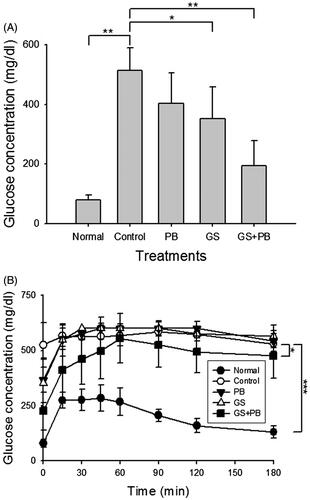
Figure 3. Effects of orally administered probiotic-fermented red ginseng on levels of blood HbA1c at the 8th week after diabetes induction. The level of HbA1c was measured in normal untreated mice (Normal), STZ-induced diabetic mice (Control), STZ-induced diabetic mice treated with probiotics only (PB), STZ-induced diabetic mice treated with red ginseng (GS), and STZ-induced diabetic mice treated with probiotic-fermented red ginseng (GS + PB). Data are presented as means ± SD (n = 4). *p < 0.05 and **p < 0.01 indicate significant differences.
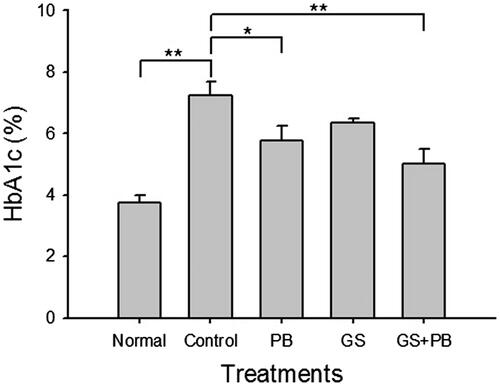
Figure 4. Effects of orally administered probiotic-fermented red ginseng on levels of (A) blood insulin and (B) blood α-amylase activity at the 8th week after diabetes induction. Blood was drawn from the normal untreated mice (Normal), STZ-induced diabetic mice (Control), STZ-induced diabetic mice treated with probiotics only (PB), STZ-induced diabetic mice treated with red ginseng (GS), and STZ-induced diabetic mice treated with probiotic-fermented red ginseng (GS + PB); levels of insulin and α-amylase activity were measured as described in the “Materials and methods” section. Data are presented as means ± SD (n = 4). *p < 0.01 and ***p < 0.001 indicate significant differences.
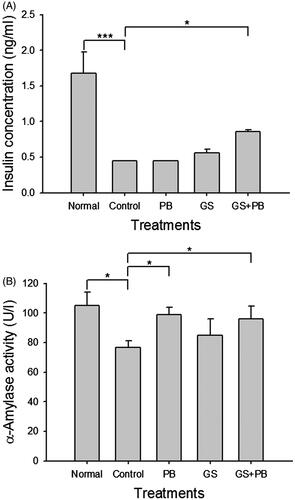
Figure 5. Effects of orally administered probiotic-fermented red ginseng on levels of blood urea nitrogen (BUN) at the 8th week after diabetes induction. Blood was drawn from normal untreated mice (Normal), STZ-induced diabetic mice (Control), STZ-induced diabetic mice treated with probiotics only (PB), STZ-induced diabetic mice treated with red ginseng (GS), and STZ-induced diabetic group of mice treated with probiotic-fermented red ginseng (GS + PB); levels of BUN were determined as described in the “Materials and methods” section. Data are presented as means ± SD (n = 4). *p < 0.05 indicates significant differences.
